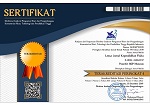The Effect of the Type and Composition of the Adhesive on the Physical Properties and the Rate of Combustion Hyacinth Biobriquettes
DOI:
https://doi.org/10.33394/j-lkf.v8i2.2786Keywords:
Biobriquettes, Water Hyacinth, Alternative EnergyAbstract
This study aimed to identify the effects of variety and composition of the adhesive used to the physical properties and the rate of combustion hyacinth biobriquettes. The physical properties referred to are water content, density and heating value. This research is an experimental study with a literacy study conducted in 3 stages, preparing tools and materials, making biobriquettes, and testing biobriquettes. The main ingredients used in the manufacture of biobriquettes are water hyacinth which is obtained at the Batujai Dam, Central Lombok Regency and the adhesive materials used are wheat flour, tapioca flour and cement. The method used to test the water content and density of the biobriquette was oven, while the calorific value and the rate of combustion were by heating water from the biobriquette combustion. The results showed that the biobriquette water content ranged from 5.138% - 13.953%, density 0.412 g/cm3 - 0.513 g/cm3, calorific value 2984.520 cal - 4476.780 cal, and combustion rate 0.029543 g/s - 0.042431 g/s. Based on the test results, it is known that the addition of adhesive material causes the water content, density, and combustion rate of the biobriquette to increase but the calorific value tends to decrease.Downloads
Published
2020-12-30
How to Cite
Ramdani, L. M. A., Ahzan, S., & Prasetya, D. S. B. (2020). The Effect of the Type and Composition of the Adhesive on the Physical Properties and the Rate of Combustion Hyacinth Biobriquettes. Lensa: Jurnal Kependidikan Fisika, 8(2), 85–92. https://doi.org/10.33394/j-lkf.v8i2.2786
Issue
Section
Articles
License
Authors who publish with Lensa: Jurnal Kependidikan Fisika agree to the following terms:
- For all articles published in Lensa: Jurnal Kependidikan Fisika, copyright is retained by the authors. Authors give permission to the publisher to announce the work with conditions. When the manuscript is accepted for publication, the authors agree to automatic transfer of the publishing right to the publisher.
- Authors retain copyright and grant the journal right of first publication with the work simultaneously licensed under a Creative Commons Attribution-ShareAlike 4.0 International License that allows others to share the work with an acknowledgment of the work's authorship and initial publication in this journal.
- Authors are able to enter into separate, additional contractual arrangements for the non-exclusive distribution of the journal's published version of the work (e.g., post it to an institutional repository or publish it in a book), with an acknowledgment of its initial publication in this journal.
- Authors are permitted and encouraged to post their work online (e.g., in institutional repositories or on their website) prior to and during the submission process, as it can lead to productive exchanges, as well as earlier and greater citation of published work (See The Effect of Open Access).

This work is licensed under a Creative Commons Attribution-ShareAlike 4.0 International License.



